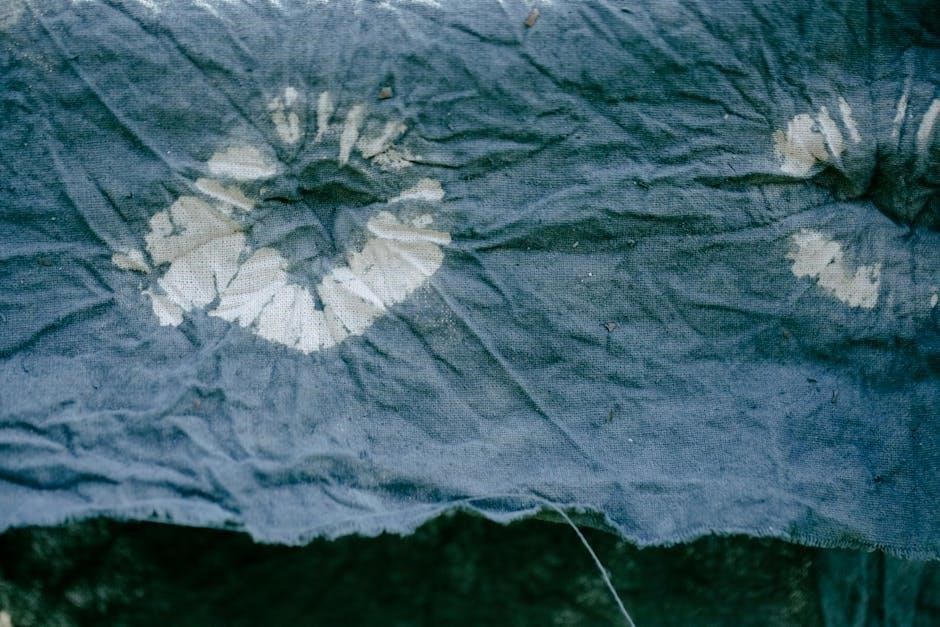Tie dye instructions pdf provides a comprehensive guide on creating unique designs, with step-by-step instructions and photos, making it easy to follow and achieve professional-looking results using various techniques and materials available.
Overview of Tie Dye Process
The tie dye process involves several steps, including preparing the fabric, mixing the dye, and applying the dye to the fabric. This process can be complex, but with the right instructions, it can be easy to follow. The tie dye instructions pdf provides a detailed overview of the process, including tips and tricks for achieving unique and professional-looking results. The process typically starts with preparing the fabric, which includes washing and drying the fabric to remove any finishes that may affect the dye. Next, the dye is mixed according to the instructions, and the fabric is folded and bound to create the desired pattern. The dye is then applied to the fabric, and the fabric is left to soak for a period of time before being washed and dried. By following the tie dye instructions pdf, individuals can create a wide range of unique and colorful designs. The process requires patience and attention to detail, but the results can be well worth the effort. With the right materials and instructions, anyone can create their own tie dye designs.

Benefits of Using Tie Dye Instructions PDF
Using tie dye instructions pdf provides easy access to step-by-step guides and photos, making the process simpler and more enjoyable for users of all skill levels always available online.
Advantages of Printable Instructions
The advantages of printable instructions are numerous, including the ability to easily distribute them to a large group of people, making them ideal for workshops or classes.
Additionally, printable instructions can be laminated, making them durable and reusable, which is especially useful for frequent tie dye projects.
They also provide a convenient way to reference the instructions while working on a project, without having to constantly switch between devices or screens.
Overall, printable instructions offer a practical and convenient solution for those looking to learn and master the art of tie dye, and can be easily downloaded from the internet.
With printable instructions, users can work at their own pace, and refer back to the instructions as many times as needed, making the learning process more enjoyable and stress-free.

Materials Needed for Tie Dye
Required materials include rubber bands, string, and dye solutions, which are essential for creating unique tie dye patterns and designs on various fabrics like cotton and linen.
Types of Fabric Suitable for Tie Dye
The type of fabric used for tie dye is crucial in achieving the desired results, with cotton and linen being the most popular choices due to their absorbency and ability to hold vibrant colors.
Other natural fibers like rayon, hemp, and silk can also be used, but they may require additional preparation and care to ensure the best possible outcome.
It is essential to avoid using synthetic fabrics like polyester and nylon, as they do not absorb the dye well and may result in uneven or faded colors.
By choosing the right fabric, individuals can create unique and colorful tie dye designs that will last for a long time, making the process of tie dyeing a fun and rewarding experience.
With the help of tie dye instructions pdf, individuals can learn more about the different types of fabric suitable for tie dye and how to prepare them for the dyeing process.

Preparing the Dye
Mixing the dye requires following specific instructions to achieve desired colors and shades using soda ash and other chemicals as outlined in tie dye instructions pdf for best results always.
Instructions for Mixing the Dye
To mix the dye, it is essential to follow the instructions carefully to achieve the desired colors and shades. The tie dye instructions pdf provides a step-by-step guide on how to mix the dye, including the right proportions of soda ash and other chemicals. The instructions also outline the importance of wearing protective gear, such as gloves and goggles, when handling the dye. Additionally, the instructions provide tips on how to create different colors and shades, such as using different ratios of dye to water or adding additional chemicals to the mixture. By following the instructions carefully, individuals can create a wide range of colors and shades, from pastel hues to vibrant and bold colors. The instructions also provide guidance on how to test the dye to ensure that it is mixed correctly and how to troubleshoot any issues that may arise during the mixing process.

Creating Different Tie Dye Patterns
Tie dye instructions pdf offers various folding techniques to create unique patterns and designs easily online.
Techniques for Achieving Unique Designs
Using tie dye instructions pdf, various techniques can be employed to achieve unique designs, such as folding, twisting, and binding the fabric to create resistance areas where the dye cannot penetrate.
The instructions provide a step-by-step guide on how to fold and bind the fabric to create different patterns, including the bullseye, spiral, and shibori techniques.
Additionally, the instructions offer tips on how to mix and match different colors to create a wide range of hues and shades, from pastel to neon.
With these techniques and tips, users can create their own unique tie dye designs, whether it’s a simple and subtle pattern or a complex and vibrant one.
The tie dye instructions pdf also includes photos and illustrations to help users visualize the process and achieve the desired results.
By following these techniques and tips, users can create beautiful and unique tie dye designs that reflect their personality and style.
The possibilities are endless, and the tie dye instructions pdf provides the necessary guidance and inspiration to get started.
Overall, the techniques outlined in the tie dye instructions pdf make it easy to achieve unique and professional-looking designs.



